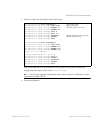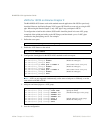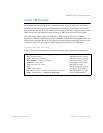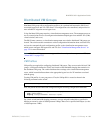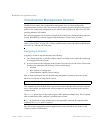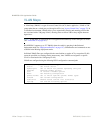
BLADEOS 6.5.2 Application Guide
BMD00220, October 2010 Chapter 13: VMready 171
Synchronizing the Configuration
When the configuration for a distributed VM group is modified, the switch updates the assigned
virtualization management server. The management server then distributes changes to the
appropriate hypervisors.
For VM membership changes, hypervisors modify their internal virtual switch port groups, adding
or removing server port memberships to enforce the boundaries defined by the distributed VM
groups. Virtual switch port groups created in this fashion can be identified in the virtual
management server by the name of the VM profile, formatted as follows:
BNT_<VM profile name>
Adding a server host interface to a distributed VM group does not create a new port group on the
virtual switch or move the host. Instead, because the host interface already has its own virtual
switch port group on the hypervisor, the VM profile settings are applied to its existing port group.
Note – When applying the distributed VM group configuration, the virtualization management
server and associated hypervisors must take appropriate actions. If a hypervisor is unable to make
requested changes, an error message will be displayed on the switch. Be sure to evaluate all error
message and take the appropriate actions to be sure the expected changes are properly applied.
Removing Member VEs
Removing a VE from a distributed VM group on the switch will have the following effects on the
hypervisor:
The VE will be moved to the BNT_Default port group in VLAN 0 (zero).
Traffic shaping will be disabled for the VE.
All other properties will be reset to default values inherited from the virtual switch.



